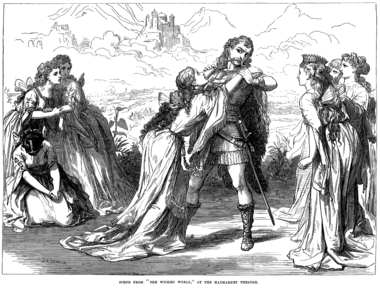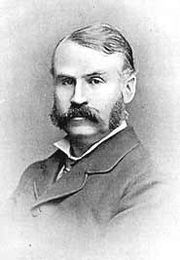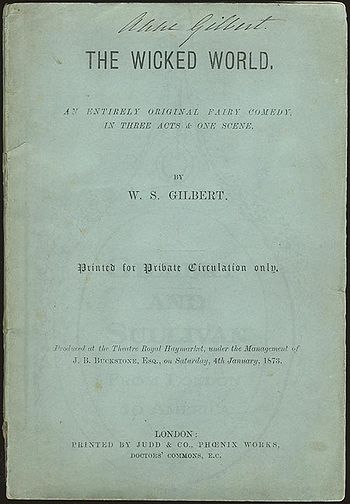
The Wicked World
Encyclopedia

Blank verse
Blank verse is poetry written in unrhymed iambic pentameter. It has been described as "probably the most common and influential form that English poetry has taken since the sixteenth century" and Paul Fussell has claimed that "about three-quarters of all English poetry is in blank verse."The first...
play by W. S. Gilbert
W. S. Gilbert
Sir William Schwenck Gilbert was an English dramatist, librettist, poet and illustrator best known for his fourteen comic operas produced in collaboration with the composer Sir Arthur Sullivan, of which the most famous include H.M.S...
in three acts. It opened at the Haymarket Theatre
Haymarket Theatre
The Theatre Royal Haymarket is a West End theatre in the Haymarket in the City of Westminster which dates back to 1720, making it the third-oldest London playhouse still in use...
on 1873 and ran for a successful 145 performances, closing on 1873. The play is an allegory
Allegory
Allegory is a demonstrative form of representation explaining meaning other than the words that are spoken. Allegory communicates its message by means of symbolic figures, actions or symbolic representation...
loosely based on a short illustrated story of the same title by Gilbert, written in 1871 and published in Tom Hood
Tom Hood
Tom Hood , was an English humorist and playwright, son of the poet and author Thomas Hood. A prolific author, he was appointed, in 1865, editor of the magazine Fun. He also founded Tom Hood's Comic Annual in 1867....
's Comic Annual, about how pure fairies cope with a sudden introduction to them of "mortal love."
Set in "Fairy Land", the action occurs within the space of 24 hours. Gilbert envisioned the set as resembling John Martin
John Martin (painter)
John Martin was an English Romantic painter, engraver and illustrator.-Biography:Martin was born in July 1789, in a one-room family cottage, at Haydon Bridge, near Hexham in Northumberland, the 4th son of Fenwick Martin, a one time fencing master...
's 1853 painting The Plains of Heaven: vaporous mountains and headlands around ethereal blue and a flowering slope on which sit white-clad angels. Gilbert also specified that the women characters 'in costume & general appearance – should suggest the idea rather of angels than of conventional fairies, and they exhibit an 'overweening sense of righteousness,' arising from their freedom from sin.
Background

Haymarket Theatre
The Theatre Royal Haymarket is a West End theatre in the Haymarket in the City of Westminster which dates back to 1720, making it the third-oldest London playhouse still in use...
for John Baldwin Buckstone
John Baldwin Buckstone
John Baldwin Buckstone was an English actor, playwright and comedian who wrote 150 plays, the first of which was produced in 1826....
and starring William Hunter Kendal
William Hunter Kendal
William Hunter Kendal was an English actor and theatre manager. He and his wife Madge starred at the Haymarket in Shakespearian revivals and the old English comedies beginning in the 1860s. In the 1870s, they starred in a series of "fairy comedies" by W. S. Gilbert and in many plays on the West...
and his wife Madge Robertson Kendal
Madge Kendal
Dame Madge Kendal GBE , born as Margaret Shafto Robertson, was an English actress of the Victorian and Edwardian eras, best known for her roles in Shakespeare and English comedies. Together with her husband, W. H...
(sister of the playwright Tom Robertson
Thomas William Robertson
Thomas William Robertson , usually known professionally as T. W. Robertson, was an Anglo-Irish dramatist and innovative stage director best known for a series of realistic or naturalistic plays produced in London in the 1860s that broke new ground and inspired playwrights such as W.S...
), in the early 1870s. These plays, influenced by the fairy work of James Planché
James Planche
James Robinson Planché was a British dramatist, antiquary and officer of arms. Over a period of approximately 60 years he wrote, adapted, or collaborated on 176 plays in a wide range of genres including extravaganza, farce, comedy, burletta, melodrama and opera...
, are founded upon the idea of self-revelation by characters under the influence of some magic or some supernatural interference. The first was The Palace of Truth
The Palace of Truth
The Palace of Truth is a three-act blank verse "Fairy Comedy" by W. S. Gilbert first produced at the Haymarket Theatre in London on 19 November 1870, partly adapted from Madame de Genlis's fairy story, Le Palais de Vérite. The play ran for approximately 140 performances and then toured the British...
in 1870, a fantasy adapted from a story by Madame de Genlis. Second was Pygmalion and Galatea (1871), a satire of sentimental, romantic attitudes toward myth, and The Wicked World was third.
These plays, together with Sweethearts
Sweethearts (play)
Sweethearts is a comic play billed as a "dramatic contrast" in two acts by W. S. Gilbert. The play tells a sentimental and ironic story of the differing recollections of a man and a woman about their last meeting together before being separated and reunited after 30 years.It was first produced on...
(1874), Charity
Charity (play)
Charity is a drama in four acts by W. S. Gilbert that explores the issue of a woman who had lived with a man as his wife without ever having married. The play analyses and critiques the double standard in the Victorian era concerning the treatment of men and women who had sex outside of marriage,...
, and Broken Hearts
Broken Hearts
Broken Hearts is a blank verse play by W. S. Gilbert in three acts styled "An entirely original fairy play". It opened at the Royal Court Theatre in London on 9 December 1875, running for three months, and toured the provinces in 1876...
(1875), did for Gilbert on the dramatic stage what the German Reed Entertainment
German Reed Entertainment
German Reed Entertainment was founded in 1855 and operated by Thomas German Reed together with his wife, Priscilla Reed née Horton...
s had done for him on the musical stage. They established that his capabilities extended far beyond burlesque and won him artistic credentials as a writer of wide range, who was as comfortable with human drama as with farcical humour. Although these fairy comedies represented a step forward for Gilbert, the blank verse is a drawback, as it limits Gilbert's vital prose style.
The plot of The Wicked World clearly fascinated Gilbert. Not only did he write a short story on the theme in 1871, but he also co-wrote a parody of it, The Happy Land
The Happy Land
The Happy Land is a play with music written in 1873 by W. S. Gilbert and Gilbert Arthur à Beckett. The musical play burlesques Gilbert's earlier play, The Wicked World...
(1873), and he returned to it in his 1909 comic opera
Comic opera
Comic opera denotes a sung dramatic work of a light or comic nature, usually with a happy ending.Forms of comic opera first developed in late 17th-century Italy. By the 1730s, a new operatic genre, opera buffa, emerged as an alternative to opera seria...
, Fallen Fairies
Fallen Fairies
Fallen Fairies; or, The Wicked World, is a two-act comic opera, with a libretto by W. S. Gilbert and music by Edward German. Premiering at London's Savoy Theatre on December 15, 1909, it failed miserably, closing after just 50 performances...
. Gilbert sued The Pall Mall Gazette, which had called The Wicked World indecent because of the references to "mortal love" in the script. Gilbert lost the case, but he had the satisfaction of having his play found inoffensive in a court of law.
Like a number of Gilbert's blank-verse plays, The Wicked World treats the subject of the consequences that ensue when an all-female world is disrupted by men, and the romantic complications they bring. His plays The Princess
The Princess (play)
The Princess is a blank verse farcical play, in five scenes with music, by W. S. Gilbert which adapts and parodies Alfred Lord Tennyson's humorous 1847 narrative poem, The Princess: A Medley. It was first produced at the Olympic Theatre in London on 8 January 1870.Gilbert called the piece "a...
(1870) and Broken Hearts
Broken Hearts
Broken Hearts is a blank verse play by W. S. Gilbert in three acts styled "An entirely original fairy play". It opened at the Royal Court Theatre in London on 9 December 1875, running for three months, and toured the provinces in 1876...
(1875), and his operas Iolanthe
Iolanthe
Iolanthe; or, The Peer and the Peri is a comic opera with music by Arthur Sullivan and libretto by W. S. Gilbert. It is one of the Savoy operas and is the seventh collaboration of the fourteen between Gilbert and Sullivan....
(1882) and Princess Ida
Princess Ida
Princess Ida; or, Castle Adamant is a comic opera with music by Arthur Sullivan and libretto by W. S. Gilbert. It was their eighth operatic collaboration of fourteen. Princess Ida opened at the Savoy Theatre on January 5, 1884, for a run of 246 performances...
(1884), are all treatments of this basic idea. Stedman calls this a "Gilbertian invasion plot". Another of Gilbert's recurring themes that is present in this play, as well as in Broken Hearts, The Yeomen of the Guard
The Yeomen of the Guard
The Yeomen of the Guard; or, The Merryman and His Maid, is a Savoy Opera, with music by Arthur Sullivan and libretto by W. S. Gilbert. It premiered at the Savoy Theatre on 3 October 1888, and ran for 423 performances...
, and other Gilbert works, is his distrust of heroic men.
Original cast

- Ethais – William Hunter KendalWilliam Hunter KendalWilliam Hunter Kendal was an English actor and theatre manager. He and his wife Madge starred at the Haymarket in Shakespearian revivals and the old English comedies beginning in the 1860s. In the 1870s, they starred in a series of "fairy comedies" by W. S. Gilbert and in many plays on the West...
- Phyllon – Mr. Arnott
- Lutin, a serving fairy – John Baldwin BuckstoneJohn Baldwin BuckstoneJohn Baldwin Buckstone was an English actor, playwright and comedian who wrote 150 plays, the first of which was produced in 1826....
- Selene, a Fairy Queen – Madge RobertsonMadge KendalDame Madge Kendal GBE , born as Margaret Shafto Robertson, was an English actress of the Victorian and Edwardian eras, best known for her roles in Shakespeare and English comedies. Together with her husband, W. H...
- Darine – Amy RoselleAmy RoselleAmy Roselle was an English actress who performed in Britain, the U.S. and Australia. She specialised in Shakespearean roles but also played parts in contemporary dramas. She married Arthur Dacre, and the two toured together with their own theatre company, eventually traveling to Australia...
- Zayda – Marie Litton
- Leila – Miss Harrison
- Neodie – Miss Henri
- Lochrine – Miss Francis
Mortals
- Sir Ethais – William Hunter Kendal
- Sir Phyllon – Mr. Arnott
- Lutin, Sir Ethais's henchman – John Baldwin Buckstone
Synopsis
PrologueIn a rhymed declaration, a character explains that the author aims to show that "Love is not a blessing, but a curse!" But the speaker disagrees with the author.
Act I
From "Fairy Land", on the upper side of a cloud, the mortal world below is visible. Two female fairies, noble, sinless beings, are curious about the nature of the "wicked world". Selene, the Fairy Queen, appears and explains that every fairy has an exact physical counterpart in the mortal world. A male fairy, Lutin, returns from a journey to the earth and sends the male fairies Ethais and Phyllon to visit the Fairy King in "mid-earth". They are to return to Fairyland with "some priceless privilege" for the fairies.
After the two fairies leave, the others decide to bring up to Fairyland the mortal counterparts of Ethais and Phyllon, as a law of Fairyland allows them to do. They hope to convert these mortals to the virtuous life by the power of their example. They are also curious about "the gift of Love", which, Selene tells them, is the one compensation mortals have been given for all the evils they must endure on earth. Selene magically summons the mortals to Fairyland.
These counterparts are "barbaric knights", engaged in fighting a duel with each other at the moment that they are transported into the clouds, and Sir Ethais is wounded. They call off the fight for the moment, realising that they are surrounded by beautiful women. The women are impressed by these men: Selene exclaims, "what can gods be like if these are men?" A fairy, Darine, and Selene are both attracted to Sir Ethais. Lutin re-enters, and Sir Ethais mistakes him for his servant Lutin, the mortal counterpart. Lutin, seeing that "mortal love" has struck the fairies, is disgusted, and explains that "love is but the seed;/The branching tree that springs from it is Hate!". Feeling out of place, Lutin angrily goes to join the other two male fairies in mid-earth. Selene kneels at the feet of Sir Ethais, declaring that she loves him.
Act II
Darine and other fairies are waiting by the entrance to Selene's "bower", where Selene has been nursing the wounded Sir Ethais for six hours. The fairies complain to each other about Selene's conduct: "Surely this knight might well have learnt on earth/Such moral truths as she is teaching him." When Selene appears, the others treat her with ironic politeness and leave. Sir Ethais is better now and has declared his love for her. She is naively romantic, while he is a gallant, smooth-talking cad. She gives him a ring as a pledge of love, and they return into her bower.
Darine is still in love with Sir Ethais, and she is intensely jealous. Sir Phyllon tells her that she can win Sir Ethais's love by healing him with a "panacea that will heal all wounds", which is in the possession of Ethais's servant Lutin, a comic character. Darine persuades Selene to summon the mortal Lutin to Fairyland. The servant, finding himself surrounded by beautiful women, concludes: "By some mistake my soul has missed its way,/And slipped into Mahomet's Paradise!" So starved are the fairies of "mortal love" that even he earns their affection.
The mortal Lutin is married to the mortal counterpart of Darine. When the fairy Darine enters, he naturally assumes that, unfortunately, his wife has also been transported to this paradise. Darine asks him for the panacea to heal Sir Ethais, disclosing that she loves Ethais, and Lutin is outraged. Why should he assist his wife's love affairs? He gives her a sleeping potion, telling her that it is the panacea. Darine tells Sir Ethais that Sir Phyllon claims he is a coward and is exaggerating the seriousness of his wound. Sir Ethais, enraged, wants to resume the fight, but he is prevented by his wound. Darine says she has Lutin's panacea, and gives it to him in exchange for a pledge of his love for her – the ring that Selene gave him.
Selene enters, and Darine berates her for introducing mortal love to Fairyland. Selene, seeing the justice of this, resigns as Fairy Queen, and the coronet is placed on Darine's head. Darine also shows her the ring that Sir Ethais has given her. Selene is shocked and disillusioned, becoming bitterly angry with Sir Ethais, Darine, and her fellow-fairies. She cries: "Are ye not content?/Behold! I am a devil, like yourselves!"
Act III
The sleeping potion has worked on Sir Ethais, and he cannot be awoken. The mortal Lutin is told that Darine is not his wife, but merely her fairy counterpart. Relieved, he gives her the real panacea, which she immediately gives to Sir Ethais. He revives and attacks Sir Phyllon, who he believes called him a coward. Phyllon denies it, and Darine admits that she lied to gain Ethais's love. Both men are disgusted by this. Sir Ethais apologises to Selene for betraying her love, but he is appalled by the bitter intensity of her feelings, which is the result of a mortal passion being put into an immortal body.
The three male fairies are returning, and their mortal counterparts must leave. Selene tries to hold Ethais back, because her love for him, though embittered, still burns. Saying, "I go to that good world/Where women are not devils till they die!", he shakes her off and leaps off the cloud and back to earth.
Final Scene
As the mortals disappear, the fairies seem to be awakening from a dream. They regain their true, virtuous selves and are ashamed of their former conduct. Darine and Selene are reconciled, and Selene says that they have no right to feel superior to mortals who fall from virtue more readily because they have been more often tempted. The fairies Lutin, Ethais and Phyllon have brought great news. Their king has decided to bestow on the fairies the gift of mortal love! Selene's final speech, rejecting this gift, prefers the fairies' life of placid tranquillity to the interesting but tempestuous life the mortals enjoy. "No, Ethais – we will not have this love!"

